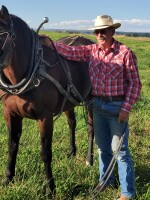Last week, the Bureau of Land Management announced a new draft plan to protect the greater sage grouse, a bird that inhabits sagebrush range lands in Colorado, Utah and eight other western states. Sage grouse nest on the ground and are best known to bird watchers for the strutting displays by males during mating season. BLM officials pointed out that there were once millions of greater sage grouse on these lands, but now their numbers are fewer than 800,000, mostly due to habitat loss due to overuse of the land for many activities. The BLM manages nearly 67 million of 145 million acres of greater sage-grouse habitat in the United States, and the agency states that “These same lands help to sustain Western rural economies built on outdoor recreation, ranching, farming, energy development and small businesses, and are also critical habitat for more than 350 other wildlife species, including pronghorn antelope, mule deer and the pygmy rabbit.” These lands are also the source of headwaters for the West's major river systems. According to the BLM, these habitat losses have been exacerbated by climate change, which has resulted in drought, increasing wildfires, and is supporting invasive species such as annual grasses. The National Cattlemen's Beef Association and Public Lands Council immediately called for a longer comment period to allow for more examination of the details, since the 600 page proposal could negatively affect public lands ranchers. The links below provide additional information about this proposal:
https://www.blm.gov/press-release/blm-proposes-stronger-greater-sage-grouse-conservation-plans
https://www.dtnpf.com/agriculture/web/ag/news/article/2024/03/15/blm-proposes-new-public-land-limits
In 2001, an outbreak of foot-and-mouth disease in the United Kingdom began when infected pork from Asia was smuggled into the Kingdom. This caused a crisis in British agriculture and tourism. It took almost two years to control the outbreak by slaughtering and burning all livestock that had been exposed to the disease. This outbreak crippled the Kingdom’s livestock agriculture for much of the decade. So it has made sense to ban the importation of beef, pork and lamb from Paraguay for the past 25 years due to sporadic outbreaks of the disease in that country. According to the USDA, foot-and-mouth disease is a severe and highly contagious viral disease that causes illness in cows, pigs, sheep, goats, deer, and other animals with divided hooves. While it doesn’t affect horses, dogs, or cats, and is not a public health or food safety threat to humans. But in November of 2023, the USDA’s Animal and Plant Health Inspection Service finalized a rule allowing fresh beef imports from Paraguay. Whether this was an act of political expediency concerning the government of Paraguay or a questionable call by the USDA is unknown. But in a rare show of bipartisan consensus, the Senate easily passed a resolution last week to overturn USDA’s rule that would allow Paraguayan fresh beef imports. The resolution will now be considered in the U.S. House of Representatives.
By now, listeners are likely aware that we are in the middle of the KSJD Spring fund drive. Please make a donation to support this station’s high quality programming that provides both entertainment and information about what’s happening in our community and the world. You can give online at https://www.ksjd.org/yes-i-support-ksjd
American educator, author, and orator Booker T Washington wrote, “A lie doesn’t become truth, a wrong doesn’t become right, and evil doesn’t become good, just because it is accepted by a majority.”



